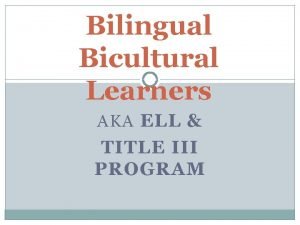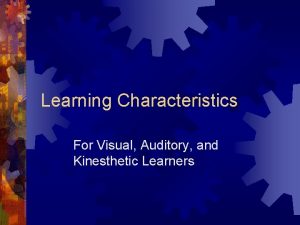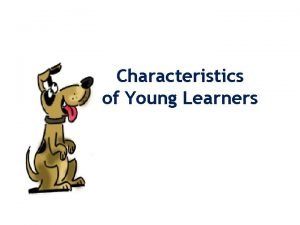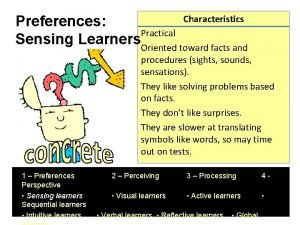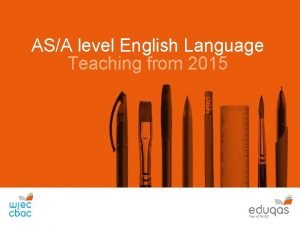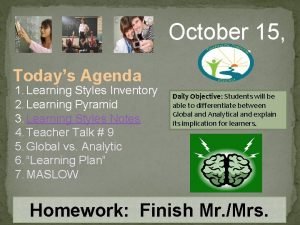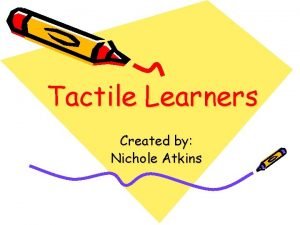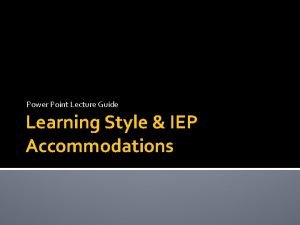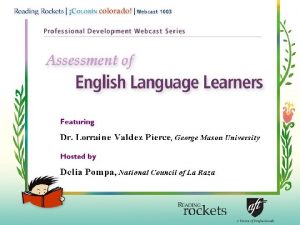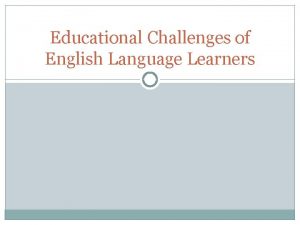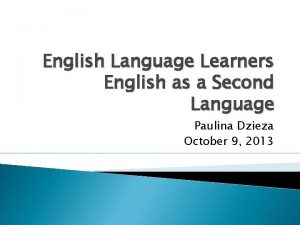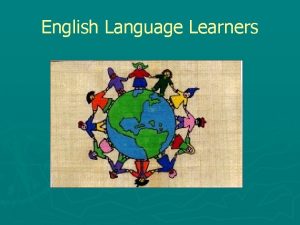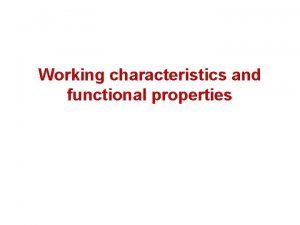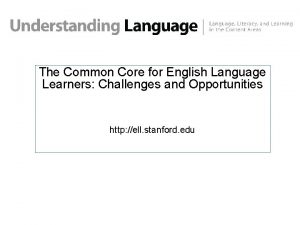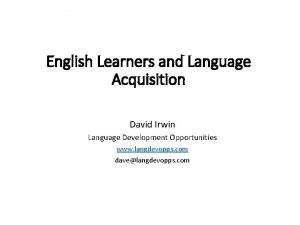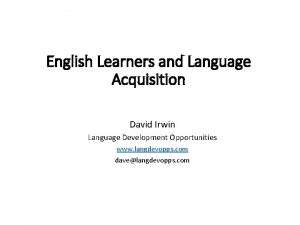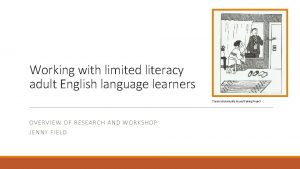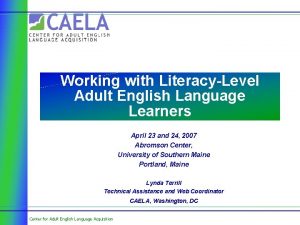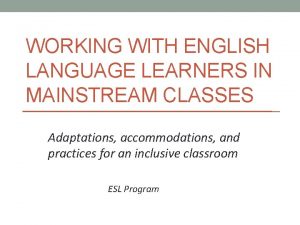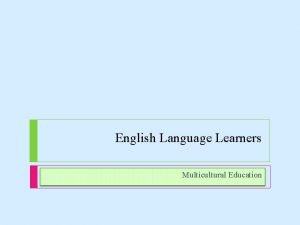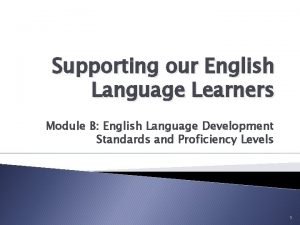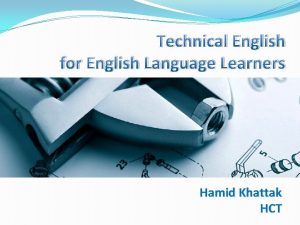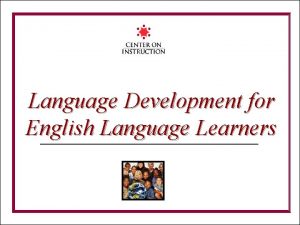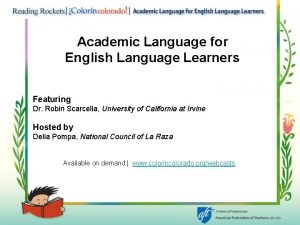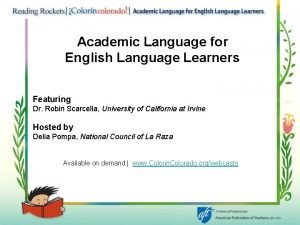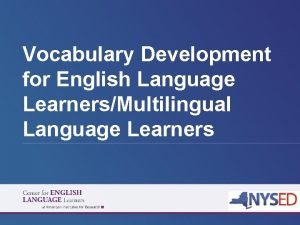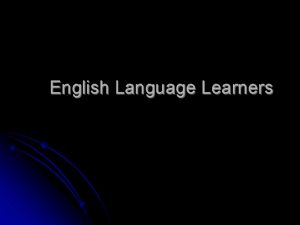Working with English Language Learners Characteristics and Challenges

























- Slides: 25

Working with English Language Learners: Characteristics and Challenges Prepared by Deniz Gokcora, Ph. D. Assistant Professor, Department of Academic Literacy and Linguistics, BMCC

Common (Mis)perceptions English language learners (ELL) need most help in grammar. ELLs think in a “different” way, so they compose paragraphs and essays in a “different” way. ELLs have vocabulary challenges; therefore, they cannot understand academic texts. Working on academic writing assignments with ELLs often takes longer than native speakers.

I. Diversity of ELL Writers II. Thinking Patterns III. Problems/Solutions IV. Tips and Strategies

ELL Students Come from diverse backgrounds ◦ Little experience with writing, some experience with writing or lots of experience with writing

Who are they? Undergraduates who graduated from U. S. high schools – immigrant students International students who are expected to return to their countries International graduate students or professionals (Leki, 2009)

Immigrant students with U. S. High School Degrees (Gen. 1. 5) May have recently arrived students Might be born in the U. S. Can pass as a native speaker verbally Might have poor academic skills/academic writing Fluent in speaking/academic topics might be more challenging/personal essays might be easier Emotional/cultural issues Familiar with American culture Need help from tutors

Who is Generation 1. 5? 2 nd Generation Children of Immigrants. Born in the U. S. Advanced Skills in English (L 2) 1 st Generation Adult Immigrant Born overseas; better language skills in L 1 Generation 1. 5 Children of immigrants; born overseas/educated in the U. S. ; advanced in speaking and poor in academic skills; English (L 2) is sometimes better than the native language; communicate with parents in L 1

International Students Better in academic skills Proud to be educated in the U. S. Lack of familiarity with slang and American culture Work ethic Strong in grammar Weak in fluency Reading articles several times For tutors/SI Leaders it is easier to work with them

International Graduate Students Need to do high-stakes writing (dissertation, papers for publication) They want feedback Loss of social status Discipline based topics are easier compared to personal topics It is easier to work with them

Some Thinking Patterns Informing ESL Writers’ Way of Thinking Robert Kaplan’s classification of cultural thought patterns provide interesting examples of digression-indirectness

PROBLEM # 1 – ASSIGNMENT UNCERTAINTY SOLUTION: Always ask for the instructions of the assignment Find what the requirements are Get the student to ask questions to the professor Role play to demonstrate how it can be clarified

PROBLEM # 2: STUDENT HAS LIMITED BACKGROUND KNOWLEDGE OF THE PAPER TOPIC SOLUTION: Encourage reading with comprehension and research

PROBLEM # 3: ENCOUNTERING MULTIPLE ISSUES IN THE PAPER (LACK OF COHESION, NO INTRODUCTION AND CONCLUSION, MINIMAL CONTENT, GRAMMAR MISTAKES, PLAGIARISMCULTURAL DIFFERENCES) SOLUTION: Prioritize the issues Higher Order Issues --- Low Order Issues (be flexible) ◦ Content Development/Brainstorm Ideas ◦ Organization: outlining/Introduction-Conclusion ◦ Grammar issues, syntax (Does each grammar mistake need to be corrected? ) ◦ Word Choice ◦ Spelling

PROBLEM # 4 – INAPPROPRIATE WORD CHOICE OR PHRASING ELLs might be unfamiliar with language/vocabulary Power: ELLs need to be in control of their writing as much as possible. How can SI leaders ensure power? Provide choices – i. e. accommodation, house, home, residence Modeling – different paragraphs, variety in sentences, transitions

EXERCISE A Sentence combining from Great Paragraphs, p. 244 School uniforms should be mandatory. This should be for all students. The students are in the United States. This is for a number of reasons. you: _________________________________ 1. 2. 3. 4.

EXERCISE B Sentence combining 1. 2. 3. 4. 5. 6. Karla is extremely happy. Karla got a car. Her car is new. Karla’s car was a gift. The purpose of the gift was for her birthday. On this birthday, she turned 30. you: _________________________________

PROBLEM # 5 : THE SILENT STUDENT Some ESL students do not know how to start and think they do not have anything to write on a specific topic Solution: Ask questions; encourage input Show an example of academic writing Be ready to give an example Use the graphic organizer as a brainstorming tool – starting point Clustering , mind mapping

WHAT IS CLUSTERING? Prewriting Sleep disorders Heart attacks Health problems later in life Lunch and snack are high in sugar and fat Diet Obesity in children genetics “product placement” of foods in popular movies, TV shows TV ads for unhealthy foods exercise Time spent using computer or watching TV instead of being outside Funding for athletic programs

PROBLEM # 6 - CHALLENGES OF GRAMMAR EXPLANATIONS – TENSES, ADVERBS, ADJECTIVES Solution: ELL textbooks have explanations: Betty Azar has several textbooks at different levels Use grammar websites (chomp; writer’s ref) ELL Lib. Guides (LC Lib. Guides Community) Purdue University OWL Have students correct their own errors

PROBLEM # 7 – PLAGIARISM – INTERPRETATIONS ELLs might not have heard of plagiarism might have a different point of view (legitimate/correct proper/desired----moral wrong) cultural values/western values – collective cultures vs. individualistic/ rote learning is encourages(Sherman, 1992; Deckert, 1993) Solutions: Clearly explain what “academic integrity” means Show them the university plagiarism policy

TIPS AND STRATEGIES: Treat each ELL writer as an individual with individual needs Provide models and ask questions: provide vocabulary, choice of vocabulary, models of paragraphs Encourage at least several SI review sessions Encourage reading and writing in English

TIPS AND STRATEGIES Handle resistance tactfully and patiently Some ELLs may: Work on Low Order Composing Skills instead of High Order Composing Skills Prolong the review session(s) Expect SI Leaders to think and compose Want to work with one SI Leader only

ONE LAST POINT TO CONSIDER: LEARNING STYLES Think Outside of the Box: learning. Learning styles are different approaches to

Module Assignment If you are participating in this module in person, please find a partner, and I will give you a review session planning sheet. If you are participating in this module virtually, please download and save it to your computer. Email the completed assignment to ccomeaukirschner@bmcc. cuny. edu Use the review session planning sheet to plan a lesson that would address Problem #1 (Slide 11) or Problem #7 (Slide 20) Take 15 -20 minutes to plan the review session.

References Deckert, G. D. (1993). A pedagogical response to learned plagiarism among tertiary-level ESL students. Journal of second language writing, 2, 94 -104. Harris, M. , and Silva, T. (1993). “Tutoring ESL students : Issues and options. ” College composition and communication 44, 525 -537. Print. Leki, I. (2009). "Before the conversation. A sketch of some possible backgrounds, experiences, and attitudes among ESL students visiting a writer center. " In Shanti Bruce & Ben Rafoth. (Eds. ), A guide for writing center tutors. (2 nd ed. ), (pp. 17). Portsmouth, NH: Heinemann, Print. Sharman, J. (1992). Your own thoughts in your own words. ELT Journal , 46, 190 -198.
 Audioize
Audioize English language learners
English language learners Reading strategies for english language learners
Reading strategies for english language learners Equal protection for english language learners
Equal protection for english language learners Teaching young learners english
Teaching young learners english Auditory learners characteristics
Auditory learners characteristics Young learners characteristics
Young learners characteristics Global learners characteristics
Global learners characteristics Hot working and cold working difference
Hot working and cold working difference Advantage of cold working
Advantage of cold working Machining operations
Machining operations Pengerjaan panas
Pengerjaan panas Smart vs hard working
Smart vs hard working Resolution 435 series of 1997 insights
Resolution 435 series of 1997 insights National program for gifted filipino
National program for gifted filipino Passive learning vs active learning
Passive learning vs active learning Levels of language knowledge
Levels of language knowledge Global vs analytical learners
Global vs analytical learners Teaching grammar to young learners
Teaching grammar to young learners Facts about tactile learners
Facts about tactile learners Definition of remedial teaching
Definition of remedial teaching Global vs analytical learners
Global vs analytical learners Lazy learners vs eager learner
Lazy learners vs eager learner Kinetic learning
Kinetic learning When is cognitivism beneficial for learners
When is cognitivism beneficial for learners Diversity of learning domain
Diversity of learning domain

